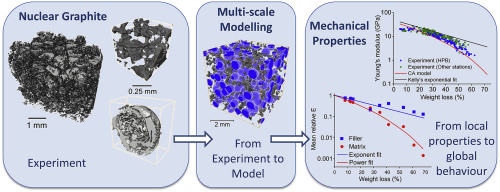A multi-scale three-dimensional Cellular Automata fracture model of radiolytically oxidised nuclear graphite
A multi-scale approach for fracture simulation, based on the Cellular Automata technique, has been developed and then applied to a nuclear graphite that is used in structural components of the UK Advanced Gas-cooled Reactors (AGR).

High resolution X-ray computed tomographs of Gilsocarbon grade
graphite, with up to 68% weight loss by radiolytic oxidation, provide quantitative descriptions of the porosity within its constitutive filler particles and their surrounding matrix. The statistical distributions for tensile strength and elastic modulus obtained from small models of the filler and matrix are introduced to a large scale model of the heterogeneous microstructure. These microstructure-derived simulations achieve a good agreement with experimental data. The computationally efficient analysis is then
used to investigate the stochastic effects on mechanical properties of possible variations in the microstructure between individual small test specimens. As these may represent material of nominally the
same microstructure, there is an apparent increase in the variability of strength and modulus at high weight loss.